Ivan Čuk
Editorial
Anton Gajdoš, Maria Provaznikova, Stephen J. Banjak
150 YEARS OF THE SOKOL GYMNASTICS IN CZECHOSLOVAKIA, CZECH AND SLOVAK REPUBLIC
Myrian Nunomura, Yoshinori Okade, Paulo Carrara
HOW MUCH ARTISTIC GYMNASTICS COACHES KNOW ABOUT THEIR GYMNASTS MOTIVATION
Fernanda Faggiani, Allistair P. McRobert, Zoe Knowles
DEVELOPING PRE-PERFORMANCE ROUTINES FOR ACROBATIC GYMNASTICS: A CASE STUDY WITH A YOUTH TUMBLING GYMNAST
Proios Miltiadis, Mavrovouniotis Fotios, Proios Michalis
PROPOSAL OF PSYCHOLOGICAL PREPARATION IN ARTISTIC GYMNASTICS
Mateja Kunješić
PARENT'S EXPECTATIONS TOWARDS CHILDREN ARTISTIC GYMNASTICS EXERCISE
Bessem Mkaouer, Samiha Amara, Zouhair Tabka
SPLIT LEAP WITH AND WITHOUT BALL PERFORMANCE FACTORS IN RHYTHMIC GYMNASTICS
Ivan Čuk
Editorial
Dear friends,
Last issue made a huge interest among readers, more than 7000 visitors at our Journal web site proves our researchers around the world are doing the right stuff, which is in your field of interest.
The most important aim of our journal is to spread knowledge and also our friends from Brazilia have same idea. Please do not forget between 5th and 6th October 2012 in Rio Claro (Sao Paulo State University, Brasilia) will be organized 3rd International Seminar on Artistic and Rhythmic Competitive Gymnastics. You have still time to join them and also test what can you expect at Olympic Games 2016. More information you can find at next page.
At Faculty of Sport, University of Ljubljana, we are organizing Symposium Youth Sport 2012, the programme can be found at http://www.youthsport.si/.
Slavic nations are celebrating 150 years of Sokol gymnastics in their countries. The first Sokol club started in Praque in 1862 and more about Czech and Slovak gymnastics you can find in the first article written by well known Professor Ph.D Anton Gajdoš with Maria Provaznikova. It is worth to note another Anton Gajdoš idea of preparing National encyklopedy of Sport in Slovakia - from 1840 till present time www.sportency.sk.
The second article is from Myrian Nunomura (Brazila); Yoshinori Okade (Japan); Paulo Carrara(Brazilia) and covers very interesting topics – how much coaches know about gymnasts motivation, or better where is their lack of knowledge.
The third article comes from United Kingdom. Authors Fernanda Faggiani, Allistair P. McRobert and Zoe Knowles prepared article with title Developing pre-performance routines for acrobatic gymnastics: A case study with a youth tumbling gymnast, it is the first article dealing with acrobatics, but their experience can be used in any gymnastics sport.
The Greek authors Proios Miltiadis, Mavrovouniotis Fotios, and Proios Michalis are rounding psychological topics in this issue with review article titled Propolsal of psychological preparation in artistic gymnastics. Important topics for coaches to what they should be also focused beside the technical training.
The fifth article is from Croatia young researcher Mateja Kunješić, she was researching what are parents expectations for their children exercising gymnastics. It is worth to note, despite injuries in high performance gymnastics, the main reason is child health, competitions are not important by itself and even more surprisingly, there is no differences between mothers and fathers. T
he last article comes from Tunisians Bessem Mkaouer, Samiha Amaraand Zouhair Tabka. They made a biomechanical analysis of split leap with and without ball throw-catch. With task to throw and catch the ball the biomechanic parameters of split leap change significantly. It is a matter of motor control and article brings us inside of which parameters we are changing to catch ball.
I wish you pleasant reading and a lot of inspiration, for preparing new researches and articles.
Anton Gajdoš, Maria Provaznikova, Stephen J. Banjak
150 YEARS OF THE SOKOL GYMNASTICS IN CZECHOSLOVAKIA, CZECH AND SLOVAK REPUBLIC
Gymnastics in Slavic countries started in 1862 with Sokol club in Prague. Leader Miroslav Tyrš made strong organisation within Austro Hungary imperia, which competed also at Olympic Games under Bohemia name. After World War I Czech and Slovak nations joint in new state Czechoslovakia. Time between world wars was most succesfull time with many gold medals at Olympic games and Word Championships. After the second world war communist party took a leading role in gymnastics development with highlight on women side; Vera Caslavska is the best athlete of this time. After velvet revolution Czechoslovakia split into two countries Czech and Slovakia. Gymnastics tradition continues again under Sokol brand name
Keywords: history, gymnastics, Czech, Slovakia.
Myrian Nunomura, Yoshinori Okade, Paulo Carrara
HOW MUCH ARTISTIC GYMNASTICS COACHES KNOW ABOUT THEIR GYMNASTS MOTIVATION
Sport seems to increasingly attract children and youth participation worldwide, possibly because many of them dream of competing in the Olympics, becoming champions, and being financially rewarded. However, only a few are aware of the level of commitment and sacrifices required in order to succeed. The purpose of this study was to analyze the Brazilian coaches’ perceptions of their athletes’ motivation and how they deal with this issue. Results revealed that Artistic Gymnastics training seems to highly demand gymnasts’ motivation to practice, and some strategies used by coaches to motivate gymnasts should be carefully reviewed. Other motivational strategies are limited due to the circumstances of the sport in Brazil, particularly regarding investment in infrastructure and support for gymnasts.
Keywords: artistic gymnastics, motivation, coaches’ perception
Fernanda Faggiani, Allistair P. McRobert, Zoe Knowles
DEVELOPING PRE-PERFORMANCE ROUTINES FOR ACROBATIC GYMNASTICS: A CASE STUDY WITH A YOUTH TUMBLING GYMNAST
A mixed-method approach was used to examine the development and acquisition of a personalized pre-performance routine (PPR) by a male youth gymnast. The athlete completed the Test of Performance Strategies and participated in semi-structured interviews alongside video clips to examine PPR experience at pre and post intervention then at 6 months follow up. There was a perceived increase in the effective use of psychological skills post intervention. Moreover, the gymnast reported a consistent PPR prior to performance, demonstrating control and automaticity of his routine. The strategy used to develop the individual PPR and its potential use with young athletes more generally is discussed.
Keywords: pre-performance routines, mixed methodology, case study
Proios Miltiadis, Mavrovouniotis Fotios, Proios Michalis
PROPOSAL OF PSYCHOLOGICAL PREPARATION IN ARTISTIC GYMNASTICS
The athletes’ psychological preparation constitutes part of the whole athletic preparation. However, the implementation of psychological skills training programs to gymnasts is rather limited and has a vague outcome. The purpose of the present paper was to make a proposal with the aim to assist the development of psychological skills training programs in artistic gymnastics. This proposal maintains that such a program should have the following objectives: (1) reinforcement of inner motives, such as volition, (2) avoidance of negative feelings, such as fear, and (3) implementation of a series of other practices discussed in the paper.
whole article in *.pdf
Key words: Artistic gymnastics, psychology, training
Mateja Kunješić
PARENT'S EXPECTATIONS TOWARDS CHILDREN ARTISTIC GYMNASTICS EXERCISE
The aim of this study is to determine the reasons for referral of the child in gymnastics such as expectations of success in sport and parent's relation towards exercise. On the sample of 55 fathers and 60 mothers of children athletes, a questionnaire was applied to find out parent's attitudes and expectations for children achievements in artistic gymnastics. Descriptive statistics, correlation and chi-square test were used to get out results. Results of Chi-squared test showed that there is no statistically significant difference between mothers and fathers in reasons to involve their child in gymnastics nor expectations of child's achievements.
Key words: children, attitudes, physical activities of parents, gymnastics
Bessem Mkaouer, Samiha Amara, Zouhair Tabka
SPLIT LEAP WITH AND WITHOUT BALL PERFORMANCE FACTORS IN RHYTHMIC GYMNASTICS
In rhythmic gymnastics execution quality depends directly on the level of technical expertise, as well as physical performance of the gymnast. the objective was to study the variation of execution factors, particularly the strength, speed and flexibility when performing gymnastics’ jumps split leap with and without throw-catch the ball. Five female gymnasts aged 12 to 15 years members of Tunisian national team of rhythmic gymnastics participated in this study. Every gymnast realized the split leap four times without apparatus and with apparatus. 2D motion analysis has been established to study the split leap with and without throw-catch the ball. The results show a significant variation of execution factors when introducing the apparatus such as the initial velocity, vertical displacement, the fly time, the component of vertical and horizontal force and the angular velocity of the split. When performing the split leap with apparatus, execution parameters show a significant decrease with the exception of the vertical velocity, acceleration and angular velocity of the split, which increase to compensate for the fall signs of strength and vertical displacement. Finally, the results showed also that probably gymnasts did not perform a jump with apparatus the best way that could.
Keywords: dual-task, split leap, throw-catch, force, speed, flexibility









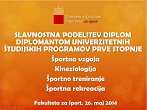
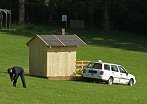
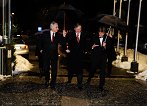
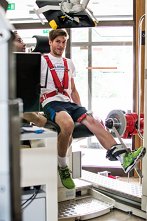
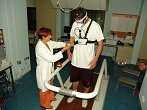
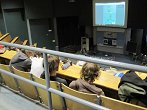


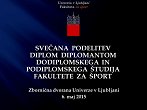













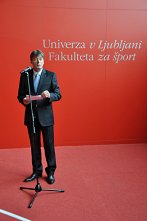


.png)